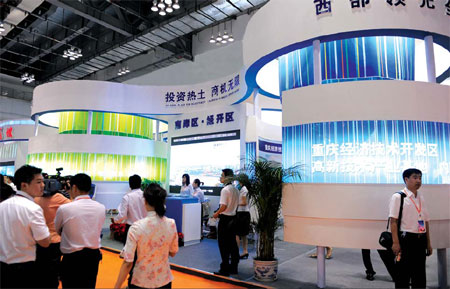China's latest municipality provides a hub that serves western regions
Updated: 2011-08-18 08:17
By Zhao Xie (China Daily)
|
|||||||||||
|
The development zone is promoted at the 14th China Chongqing International Investment Fair. |
One reason for its success in getting more investment is a five-day promotion event it sponsored this past February in Hong Kong
An economic development zone in the mega-city of Chongqing is attracting greater attention from investors in China and abroad because of its position as an economic hub for the western parts of China and competitiveness in many sectors.
The Chongqing Economic and Technological Development Zone opened in 1993 as a State-level development zone, just four years before Chongqing became the latest of China's four municipalities.
The zone is becoming an important area for manufacturing, trade, services, transportation, and logistics, and has a pivotal role in promoting urban growth by providing a base for overseas and domestic investment.
One reason for the zone's success, in getting more investment, is surely the five-day promotion event it sponsored this past February in Hong Kong.
That lead to talks with more than a hundred business leaders there, accompanied by an exhibition to introduce investment projects and the Chongqing business environment.
It also leads to about 15 billion yuan worth of cooperative agreements on 15 large projects in the automobile, warehousing, logistics, information technology, finance, and infrastructure sectors.
According to the zone's administrative committee, more than 40 Fortune 500 companies - including Hutchinson Whampoa, Honda, Suzuki, Ford, Ericsson and Coca Cola - have plants or offices there, along with a large number of other multinationals and Chinese businesses.
Why Chongqing zone?
Well, for one thing, there is its advantageous location and convenient transport. Then there is the infrastructure and industrial base, all of which help. And Chongqing is a hub with connections to China's western and central parts.
The zone's products can easily be moved down the Yangtze River to cities like Yichang, Wuhan and Shanghai and on to other parts of the country or the world.
It also has a number of highways, expressways and railways, as well as Jiangbei Airport, only 15 minutes away.
Inside the city, the zone is accessible through a number of roads and two subway lines. There are also bridges across the Yangtze to other parts of Chongqing, and a new one in the works.
It also has adequate water, power, gas, telecommunications, and sewage treatment facilities.
In two decades, the zone has developed an industrial system covering automobiles, motorcycles, electronic information, biomedicines, fine chemicals, new materials, food processing, and garments.
Its emerging industries in recent years include shipbuilding, numerically controlled machine tools, the Internet-of-things, logistics, and new energy.
Other attractions are the zone's amenities for living and services such as education, from kindergarten to university; health care, from community to top-level hospitals; shopping, entertainment, recreation, and sports.
Expansion plans
Expansion plan in recent years involve greater opportunities to investors, such as a new area in Chayuan, to the south of the Yangtze River. This 59-square-kilometer area is an example of the need for investment in both infrastructure and industrial development.
Local authorities expect the economic and technological development zone to be an important force in the municipality's growth.
The administrative committee has predicted that projects over the next four years will need 200 billion yuan in backing and will have an output worth 100 billion yuan by 2015.
The goal is to turn the zone into a high-level industrial base for advanced manufacturing, modern services, logistics, and high-tech R&D.
The committee has said they expect the zone to have more than 80 high-tech R&D companies by 2015, with annual revenues above 20 billion yuan.
They have also estimated that they will have around 50 multinationals, including 20 Fortune 500 companies, by the same year.
And protecting the environment and improving the standard of living are major concerns. Their plan calls for 60 percent of the zone to be covered by trees and grass, and a per capita green space of 22 square meters, by 2015.
The local government is getting involved by trying to improve air quality in the hope that they can have more than 320 days a year meeting national healthy-level standards.
In addition, it plans to improve public security, social welfare, and health care to make certain that its people live better, happier lives.
The Chongqing Economic and Technological Development Zone now covers a 90-sq-km area. In 2010, it reported total revenues of 96 billion yuan, an increase of 23 percent over 2009.
Its foreign trade volume was worth $2 billion the same year, a growth of 31 percent from the previous year.
